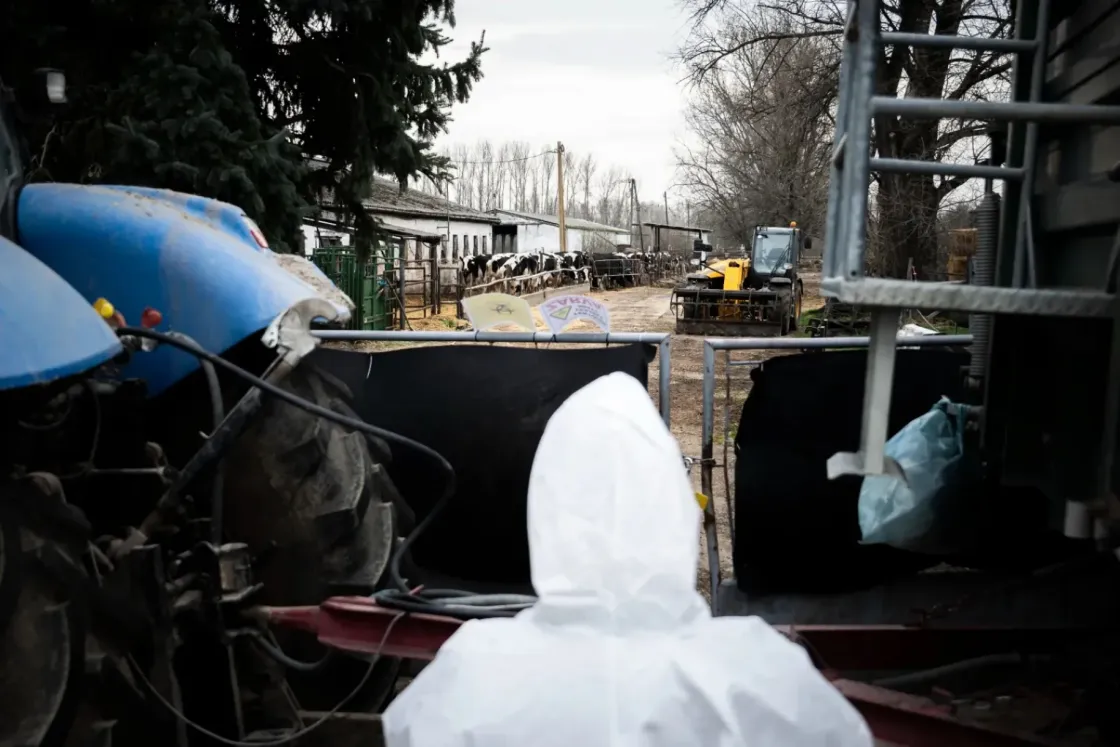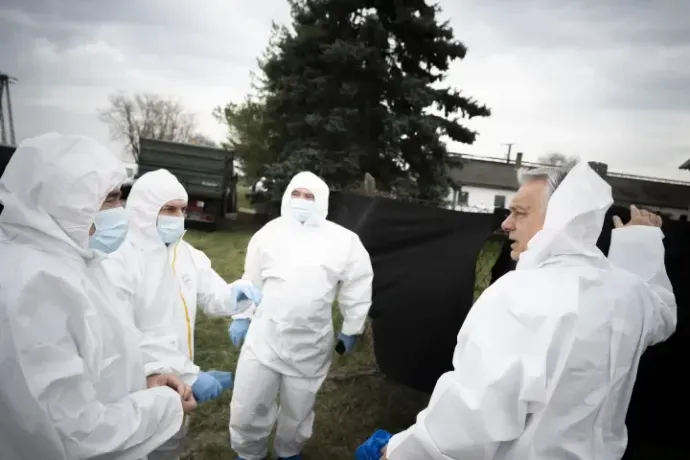
"We will see more clearly in two weeks' time, but there are basically two scenarios: either it is bad or it is really bad," an expert working in a senior position in agriculture, who asked to remain anonymous, told Telex about the emergence of foot-and-mouth disease in Hungary.
"Everyone who's raising animals is holding their breath. If the disease gets in, there is no other solution but to kill all the animals. And there are so many different ways for the virus to get in: whether it's in your hair, on your back, under your fingernails, or through migratory birds. The last time this happened in Hungary, in Bács-Kiskun county, they even shot all the sparrows around the hotspots. Although back then there were animals at all the farms, so it was much easier for the virus to spread," he says.
The National Food Chain Safety Authority (Nébih) announced last Friday that for the first time in more than 50 years, foot-and-mouth disease has been identified in Hungary at a cattle farm in Kisbajcs, Győr-Moson-Sopron county. Several immediate restrictions were introduced due to the emergence of the highly dangerous virus and all animals on the affected farm were slaughtered.
Even if there is no outbreak, it may still be painful
According to the expert we spoke with, the emergence of the virus could have a negative economic impact even if no outbreak develops.
This is because countries outside the EU could still limit exports of Hungarian meat, meat products, milk and dairy products.
This has been announced successively; the UK, for example, is taking the situation so seriously that it has not only halted exports of Hungarian meat but also of meat from Slovakia. Even if the virus is stopped at Kisbajcs, the big question is when these countries will allow Hungarian products back onto their markets.
The total Hungarian export of pork last year amounted to 170,000 tonnes, most of which is exported to other EU countries. Hungary exported 12-15 thousand tonnes to non-EU countries, which may not seem like a lot, but losing this would be a huge loss for many farmers.
Within the EU, there are specific rules on which foods' shipment may be subject to restrictions. EU experts were already in Hungary on Monday, and if they judge that the Hungarians are doing things properly and taking the necessary steps, they will probably conclude that movements within the EU should be allowed. In other words, if the virus can be stopped in Kisbajcs, then intra-EU exports could be back to normal within a few weeks.
A bigger problem, according to one of our sources, is that some of what is exported to the EU leaves the EU after additional processing. For example, it is common for Hungarian pork legs to be sold to Italy, where they are processed and sold as ham to the US. This is quite a large quantity, and if restrictions for outside the EU remain in place for a long time, it could also affect Hungary's exports within the EU.
For some farms, this could be the coup de grace
In the words of another professional source of ours, who requested anonymity, "everyone is terrified". He says that if they fail to contain the virus in time, it could even threaten the unique and extremely valuable Hungarian grey cattle (szürkemarha) population.
"There is nothing else you can do in such a situation, you must shoot up to a thousand animals with a gun. You shoot them, and the digger comes and takes them to the ditch. All of a sudden, there's no better way to deal with this than with a gun," he said, explaining what awaits any farm where the virus rears its head.

According to him, the consequences of an outbreak would be very serious even if the state were to later compensate the affected livestock farmers. “The cost of re-establishing a cattle farm is huge, a gravid heifer costs about $1,500, and setting the milk after quarantine takes one and a half to two years once the farm is back in operation. But if the plant is already run down, using outdated machinery, restarting it may not be possible. There are some farms that would probably not even be worth restarting after something like that.”
According to a source in the meat industry, who also asked not to be named, the virus and the export ban could soon lead to forced sales. In the short term, this could lead to a drop in the price of meat – especially pork – and meat products. In the medium term, however, the more animals are slaughtered, the smaller the supply will be, which could lead to higher prices. According to our source, some expect that the virus could take up to a third of the livestock, which they say could have rather dramatic effects.
What will happen to the Easter lambs?
After the virus was identified, in addition to cattle, a 72-hour ban on moving livestock was imposed on all susceptible animals, including sheep, pigs and goats in the Transdanubian region and Pest county. A lighter restriction was introduced at the end of the three-day period, allowing animals to be moved only for the purpose of slaughtering them.
Dávid Mezőszentgyörgyi, Executive Director of the Sheep and Goat Interbranch Organisation told Inforádió that the current situation is particularly dangerous for sheep farmers, as many of them sell their breeding stock as Easter lambs during this exact period. Trucks carrying sheep had to be stopped on 7 March, and Dávid Mezőszentgyörgyi said it would be detrimental to sheep farmers if exports could not be restored to the level they were at prior to the restrictions.
Virologist Gábor Kemenesi told 24.hu: "This is a brutally infectious virus, so if it gets in, the only solution is to cull the affected flock." He said the virus is fairly well known, it has been studied since the beginning of the 20th century, and since then there have been several outbreaks around the world. The most recent one was in the UK in 2001.
Kemenesi said that the 2001 outbreak had a major effect on tourism, the environment and the economy, which is why the EU has taken serious steps to prepare for a possible similar outbreak. The Hungarian authorities are now acting in accordance with the regulations drawn up at the time, for example by designating protection zones around the affected areas.
This January, the virus appeared in Germany, probably arriving from Turkey or Armenia. Szabolcs Pásztor, Hungary's chief veterinarian, told Inforadio on Monday that it is not yet known where the virus in Hungary came from, but what they do know is that it is not the same as the strain that appeared in Germany a few weeks ago.
It was identified on Friday, and by Monday even PM Viktor Orbán was not allowed to enter
Nébih announced on Friday 7 March that foot-and-mouth disease had been identified on a farm with 1400 cattle in Kisbajcs. The highly contagious disease appeared in Hungary after more than 50 years. It is an untreatable disease, so even if just one animal on a farm contracts it, all the cloven-hoofed ones have to be killed.
This is what is happening to the animals at the Kisbajcs farm too: they are being slaughtered and moved en masse. They started digging a massive ditch in nearby Bábolna over the weekend, and the carcasses weighing more than a thousand tonnes total are being transported there by trucks. According to Róbert Pintér, a local member of the Bábolna municipality, the animals are being burned in the newly dug pit.

A 3-kilometre protection zone and a 10-kilometre surveillance zone have been set up around the location of the outbreak. According to Lóránt Szajkó, CEO of the nearby Kisalföldi Mezőgazdasági Zrt. in Nagyszentjános, most of the farms that have had contact (either animal or human) with the Kisbajcs farm have been checked and all of them tested negative – meaning that there were no infected animals. The Nagyszentjános farm, which is located 13 km from the place of the outbreak, has 2500 cattle, but they have a total of around 6000 animals, including on three other farms.
The gravity of the situation is reflected in the fact that Hungarian Prime Minister Viktor Orbán also travelled to Kisbajcs, where he said he intended to inspect the protective measures and consult with Agriculture Minister István Nagy on how the spreading of the disease could be prevented. Just how serious the situation is, is reflected in the fact that while Viktor Orbán posted about Kisbajcs as if he were at the cattle farm, it later became clear that the veterinarian supervising the slaughter of the animals would not allow either him or Agriculture Minister István Nagy to enter the premises.
Viktor Orbán posted a video from the scene in which he said: “What needs to be done is to eliminate the herd, localise the infection and prevent it from spreading. All the experts needed for this are available, and the financial resources necessary are also available. (...) I urge everyone to heed the instructions of the authorities.”
In order to prevent the spreading of the extremely dangerous disease, the closure of the Győr Zoo was announced on Saturday. Then on Monday, the petting zoo of the Budapest Zoo was also closed until further notice. Similar measures have been taken in several locations throughout Hungary, including the closure of the Hortobágy Wildlife Park.
For more quick, accurate and impartial news from and about Hungary, subscribe to the Telex English newsletter!